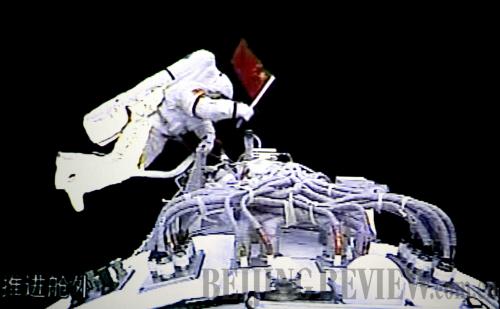|
 |
|
SPACE WALKING: Chinese astronaut Zhai Zhigang waves the Chinese national flag when he takes China's first walk in space outside Shenzhou 7 on September 27, 2008 (ZHA CHUNMING) |
China plans to launch an unmanned space module, Tiangong 1, in 2011, said Qi Faren, the chief designer of China's Shenzhou spacecraft, at the sidelines of the annual plenary session of the National Committee of the Chinese People's Political Consultative Conference (CPPCC), the country's top political advisory body, on March 3.
Tiangong, or the Heavenly Palace, will eventually be transformed into a manned space laboratory after experimental dockings by the three Shenzhou spacecrafts—Shenzhou 8, Shenzhou 9 and Shenzhou 10, which are expected to be launched into space within two years of the module's launch, said Qi.
An essential step
Qi said that Tiangong 1, which weighs approximately 8.5 tons, is expected to complete China's first space docking with Shenzhou 8 during the following year, and will perform long-term independent operations, which are regarded as an essential step toward building a space station.
The official website of China's manned space program, Cmse.gov.cn, says China is now in the second phase of a three-step plan that the nation has drafted for implementing its manned space program.
The first phase is sending astronauts into space, which was accomplished when China successfully launched its first astronaut, Yang Liwei, into space with Shenzhou 5 in 2003, said Zhang Jianqi, former Vice Commander in Chief of China's Manned Space Engineering Program.
The second phase is described by the official website as including the goals of launching spacecrafts with more than one astronaut, space walking, docking between spacecrafts and space modules, and launching short-term manned space laboratories.
The first two goals were achieved by the Shenzhou 6 and Shenzhou 7 spacecrafts separately in 2005 and 2008, said Zhang. The current focus is on the launch of Tiangong 1, and the docking of the three spaceships Shenzhou 8, Shenzhou 9 and Shenzhou 10 with Tiangong 1 following its launch.
Zhang said Tiangong 1 would be launched on a technologically-modified Long March 2-F carrier rocket.
Scientists have made nearly 170 technological modifications, including 38 major ones, to the original Long March 2-F model, he said.
Qi said clean propellants such as liquid oxygen and kerosene have replaced polluting elements in China's space programs.
Additionally, throughout the whole second phase China will need to master four technologies in order to launch the space station in the third phase, said Qi. Astronauts carried out extravehicular activity during the Shenzhou 7 mission in 2008 and scientists are now working on the challenge of space docking.
Space docking technology has been widely recognized as one of the most sophisticated space skills as it requires precise handling of two high-speed spacecraft which meet and dock in space.
The official website says any miscalculations during a docking could lead to the collision of spacecrafts.
"The Tiangong 1 is the platform for testing space docking technology," said Qi. According to current plans, Shenzhou 8 will be an unmanned spacecraft that will attempt to dock with Tiangong 1 during the following year, he said.
Scientists on the ground will control docking of the spacecraft between the orbiter and the unmanned spaceship.
If that mission is a success, manned spaceships will be launched to dock with the Tiangong 1, Qi said. "We will then improve Tiangong 1 and further develop the space laboratory."
Following conversion into a manned space laboratory, Tiangong 1 will provide a "safe room" for Chinese astronauts to live and conduct research under zero-gravity conditions.
The space laboratory will operate independently in the long term but will be taken care of by astronauts in the short term, so China will also have to solve supply problems.
"We will launch a cargo spaceship that will send several tons of supplies, including water, food, air and other items, to the space laboratory," Qi said.
At present, the Shenzhou spaceships can only carry 300 kg of payload when three astronauts are on board. Scientists will also have to overcome the problem of recycling air and water in the space laboratory.
When these problems have all been resolved, China will be ready to launch its space station on top of a Long March 5 rocket from the new launch center in Hainan Province, said Qi.
| 